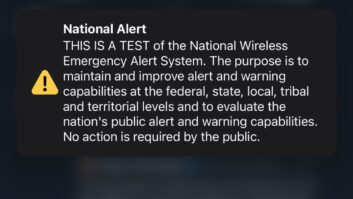Reactions are divided within the industry about whether the FCC should have delayed its deadline for stations to upgrade EAS encoders/decoders to become compliant with the new Common Alerting Protocol.
Two weeks before the Sept. 30 deadline, the FCC pushed it back again, to June 30, 2012. Some engineers who had bought new equipment to comply — generally at larger radio groups — were peeved at the decision. Some at smaller stations were relieved, saying they needed more time to come up with the money to pay for new gear.

FEMA IPAWS Program Manager Manny Centeno speaks during the Radio Show in Chicago. Photo by Jim Peck
Before the commission released its decision, manufacturers seemed to expect some sort of extension but were surprised that the FCC had moved the deadline so far out, by nine months.
One benefit is that this may help stations better focus on the separate, upcoming Nov. 9 national EAS test, according to some broadcasters and FEMA; indeed, an engineer who handles a cluster for a larger group recently told Radio World it was difficult to prepare facilities for both CAP compliance and a national test when the dates were so close together.
Broad support
In issuing its latest extension, the commission was acting on a joint petition from NAB, broadcast associations for 50 states and the District of Columbia, NPR, the Broadcast Warning Working Group and associations representing the cable industry and public television stations.
They’d asked for an extension of at least 180 days, saying EAS participants needed time to take into consideration any changes to the FCC’s Part 11 rules before making a final purchase decision on EAS equipment.
NAB also argued that an extension was necessary because the industry didn’t know whether the commission would implement its own equipment certification testing, separate from FEMA’s conformance testing — again potentially affecting equipment purchase, installation and operation decisions.
The FCC agreed, saying the extent to which it will require EAS equipment to be certified as compliant with its revised rules is “an open issue” that must be resolved.
In May, the commission had asked for comment on several tentative conclusions regarding EAS, including whether it should grant another extension. Now, in the Fourth Report and Order released Sept. 16, the FCC says it received 30 initial comments, with the majority favoring an extension of the compliance deadline.
The FCC expects to adopt CAP-based revisions to its Part 11 EAS rules in a subsequent order, and it expects those new rules to be out sufficiently in advance of the June 30, 2012 deadline in order to allow EAS participants ample time to come into compliance with those new rules.
“While we agree … that the CAP standard is well established and that there is equipment that has already been deployed that complies with that standard, we nonetheless [also] agree … that until the commission has completed its rulemaking process, it cannot meaningfully impose a deadline by which EAS participants must ‘receive CAP-formatted alerts,” wrote the FCC in its decision.
That, of course, is exactly what the FCC did in establishing a series of deadlines, which has led to industry frustration.
But the commission has not finalized all the key technical specifics necessary for receiving CAP-formatted alerts, it stated. “Without having these specifics, no EAS participant can claim that it is currently capable of receiving CAP-formatted alerts, even if it has equipment that could receive such alerts under one or more of the technical specifications being considered by the commission.”
Suzanne Goucher, president and chief executive officer of the Maine Association of Broadcasters, was pleased with the move, saying the extension “will help smaller stations.”
But of the process in general, she said final rules should be in place before stations are obliged to purchase new EAS equipment. “I would much rather we all do this once and do it right.” Another state broadcasting association executive commented, “It’s like saying, ‘Buy this DTV transmitter and then we’ll tell you the rules.”
Just the day before the extension, one small-market radio broadcast station owner, speaking to Radio World during the Radio Show in Chicago, said he hoped for an extension because he wanted to put off the expense until the next fiscal year.
But several engineers for large radio groups said the decision benefits those who took a gamble that there would be an extension and hurt those who played by the rules.
“We took the deadline seriously,” the CE of a major broadcast group said disgustedly. And some proponents of EAS feel deflated. “We’ve lost momentum,” one said.

Al Kenyon takes questions at the IPAWS booth. Photo by Jim Peck
The FCC says it doesn’t want stations to wait until the last minute to buy CAP-compliant gear: “Our extension of the CAP compliance deadline should not prevent those that wish to purchase FCC-certified, integrated CAP-capable EAS equipment from doing so or otherwise hamper the marketing activities of manufacturers of such equipment,” it wrote.
Yet manufacturers say exactly that could happen. Harold Price, president of Sage Alerting Systems, said that after the first announced extension last November, “orders dropped to zero and stayed there a long time.”
Sage and Monroe Electronics, owner of Digital Alert Systems, had opposed further extensions, saying that roughly 70 to 80 percent of the market has devices and the rest weren’t planning to buy a new unit, either at all or until they had to.
Monroe told the FCC there were few if any outstanding potential compliance issues that could not be resolved after the deadline using software/firmware upgrades.
Holding off?
Another issue is order cancellations. Manufacturers believe most customers who have units on order will take delivery and pay for them, but that some could cancel current orders and re-order in 2012.
“I am canceling my order for a new … unit,” one standalone broadcast owner wrote on a radio listserv. “I will probably buy one eventually, but I don’t see any reason to spend money now when it isn’t needed till next year.”
Such cancellations would leave manufacturers in a bind. To meet the short-term spike in demand, some had to take out loans and take other unusual steps to pay for materials and then build the units, according to a broadcast engineering source familiar with the process. Also to be considered are inventory storage space and costs.
The extension could mean that EAS manufacturers, which generally are small companies, must sit on parts or completed units rather than finish them and ship right away, one manufacturer told Radio World.
At the Radio Show, both Sage and Monroe said they’ve been engaged in a concentrated buildup to build, sell and support the new units in recent months. “We need to keep that selling mode ramped up longer now,” said Price.
“We re-tasked people for this,” said one of three Monroe representatives who spoke to Radio World on the show floor. Now, “I’m going to send people home,” presumably a reference to scaling back work force.
Some broadcasters have speculated that manufacturers, with units now ready to go, will have a fire sale in 2012; but both companies said the delay will not translate to such bargains.
After the convention, Sage sought to assure customers who’ve already purchased a unit: “People need to know that nothing has really changed, other than the date,” said Price. “The FCC has simply admitted that they can’t get all the changes into the Part 11 rules by the deadline. They didn’t say that the existing integrated devices won’t match the new rules, or that any technical changes will even be necessary. They did say they believe that technical changes, if any, can be handled by a firmware update.”
Converters
The FCC also said the extension will give it time to resolve the question of what to do about “intermediary devices,” converters that connect in some fashion with previously certified EAS equipment to allow receipt of CAP-formatted alerts. The commission still needs to decide whether such intermediary equipment must be certified under the agency’s rules and whether converters will satisfy the new CAP requirements at all.
Noting that some stations “may have purchased such equipment,” the FCC cautioned stations that EAS encoders/decoders must be FCC certified and said it remains unclear whether CAP converters or “any equipment that does not meet these current baseline requirements will be able to satisfy and CAP-related rules we may adopt in the future.”
The agency urged licensees who may have purchased or are thinking about buying any EAS equipment to verify with manufacturers and/or vendors that the gear complies with current FCC EAS equipment rules.
Touchstone Consulting Group EAS expert Gary Timm wrote on the Alerts, Warnings & Response to Emergencies blog after the convention that one FEMA executive believes the FCC could finalize its CAP-EAS rules by the end of the year.
“We will continue to push forward,” on CAP-EAS, said Antwane Johnson at an EAS session at the end of the show. Johnson is division director and program manager for FEMA’s Integrated Public Alert and Warning System Program Management Office.
“We’ve put up an EAS server, which developers are testing now,” in preparation for CAP-EAS. He told Radio World FEMA expected to issue IP addresses to PEP stations in late September so that they can connect to the IPAWS server and retrieve the EAS message that they, in turn, will transmit to other stations in the daisy chain.
And finally, FEMA, one of three federal agencies responsible for EAS along with the National Weather Service and the FCC, said it will proceed with testing in preparation for the national EAS test, which will test legacy EAS and not involve CAP.










